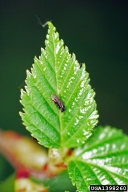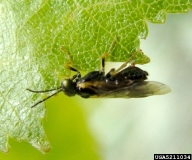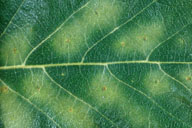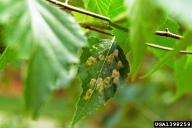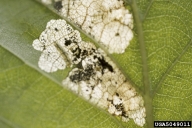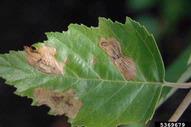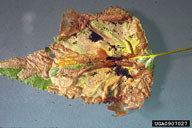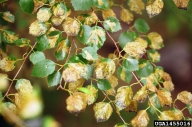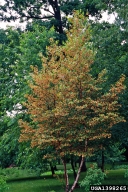Birch leafminer
Fenusa pusilla (Lepeletier) (Hymenoptera: Tenthridinidae)
Orientation to pest
The birch leafminer, Fenusa pusilla (Lepeletier), is a European sawfly that was mines the leaves of several species of birch (Betula) in North America, where it invaded just prior to the 1920s. It is found principally in southeastern Canada and northeastern USA, in the range of its main hosts, gray (Betula populifolia Marshal) and paper birch (Betula papyrifera Marshal). This sawfly overwinters as prepupae in earthen cells in the soil. Pupation occurs in spring and adults emerge near bud break. Eggs are laid singly in unfolding leaves, and larvae create leafmines where they feed. Mines are blotch shaped and enlarge and eventually merge as larvae grow. In New England, there is only one full generation per year, but a small fraction of the first and second generations develop to adults without diapause and emerge to produce a partial second and third generations. Before the 1980s, birch leafminer densities were high enough so that most leaves of white and gray birches in landscapes or road edges were mined; mined leaves being completely browned. This created an aesthetic problem on landscape trees and likely reduced the vigor of forest trees. In the period of 1970-2000, birch leafminer was subjected to biological control through introduction of its specialized parasitoids from Europe and densities in the northeastern USA have now declined to now pest levels (<5% leaves mined).
Hosts commonly attacked
The principal birch species used as hosts are gray (B. populifolia) and paper (B. papyrifera) birch. Yellow (Betula alleghaniensis Britton) and black (=sweet) (Betula lenta L.) birch are not attacked. Several introduced European birches are also attacked in landscape plantings.
Distribution
This sawfly occurs from Newfoundland (Canada) south to Maryland and west to Minnesota and Iowa, with isolated populations also in Oregon, Washington, and Alaska, especially on introduced birches planted as ornamentals.
Images of birch leafminer
| Figure 1. Adults of birch leafminer, Fenusa pusilla; left, adult on young birch leaf; right, close up | Figure 2. Eggs of birch leafminer (points), surrounded by yellow halos of tissue |
| Figure 3. Small mines of birch leafminer, showing young larvae feeding in separate mines (left); right, close up on a single mine, with larva visible | Figure 4. Middle-age and older larvae of birch leafminer, showing fusion of mines as larvae increase in size |
| Figure 5. Close up of damage on branch heavily mined by birch leafminer | Figure 6. High density of mining by birch leafminer |
Important biological control agents related to this pest species
Two European ichneumonids (Lathrolestes nigricollis [Thompson] and Grypocentrus albipes Ruthe) and one eulophid (Chrysocharis nitetis [Wilkinson]) were introduced into North America for biological control of the birch leafminer. Lathrolestes nigricollis is the only species to have become widely established. At the level of individual release sites, L. nigricollis has lowered pest density from 50 to <5% of first generation leaves being mined. At the landscape level, this parasitoid has suppressed this leafminer to insignificant levels throughout the northeastern United States, with the exception of southern New Jersey.
Web links for information on birch leafminer
- Target Pest: Birch Leafminer | University of Massachusetts Amherst
Provides information on biological control - Fact Sheet | University of Minnesota Extension
- Tree, Shrub, and Flower Growing Publication | Rutgers, The State University of New Jersey
Articles
- Cheng, H. H. and E. J. LeRoux. 1965. Preliminary life tables and notes on mortality factors of the birch leaf miner, Fenusa pusilla (Lepeletier) (Hymenoptera: Tenthredinidae), on blue birch, Betula caerulea grandis Blanchard, in Quebec. Annals of the Entomological Society of Quebec 11: 81-104.
- Eichhorn, O. And H. Pschorn-Walcher. 1973. The parasites of the birch leaf-mining sawfly (Fenusa pusilla (Lep.), Hym.: Tenthredinidae) in Central Europe. Technical Bulletin of the Commonwealth Institute of Biological Control No. 16, pp. 79-104.
- Fuester, R. W., P. B. Taylor, W. H. Day, R. M. Hendrickson Jr. and E. M. Blumenthal. 1984. Introduction of exotic parasites for biological control of the birch leafminer (Hymenoptera: Tenthredinidae) in the Middle Atlantic states. Journal of Economic Entomology 77: 1565-1570.
- Van Driesche, R. G., R. Childs, R. A. Casagrande, and L. Tewksbury. 1997. Establishment, distribution, and impact in southern New England of Lathrolestes nigricollis (Thompson) (Hymenoptera: Ichneumonidae), an introduced parasitoid of the birch leafminer, Fenusa pusilla (Lepeletier) (Hymenoptera: Tenthredinidae). The Canadian Entomologist 129: 601-611.
- Langor, D. W., S. C. Digweed, and J. R. Spence. 2001. Fenusa pusilla (Lepeletier), birch leafminer, and Profenusa thomsoni (Konow), ambermarked birch leafminer (Hymenoptera: Tenthredinidae), pp. 123-127. In: Mason, P. G. and J. T. Huber (eds.). Biological Control Programmes in Canada, 1981-2000. CABI Publishing, Wallingford, UK. Casagrande, R., R. G.
- Van Driesche, M. Mayer, R. Fuester, D. Gilrein, L. Tewksbury, and H. Faubert. 2009. Biological control of Fenusa pusilla (Hymenoptera: Tenthredinidae) in the northeastern United States: a thirty-four year perspective on efficacy. Florida Entomologist 92: 243-247. (viewable at http://www.fcla.edu/FlaEnt/fe92p243.pdf)
